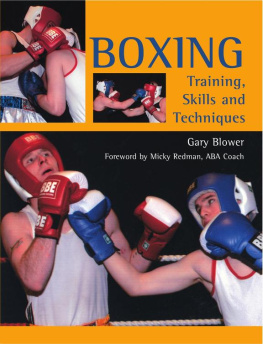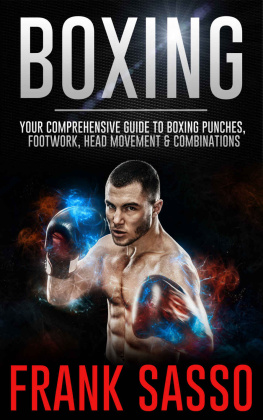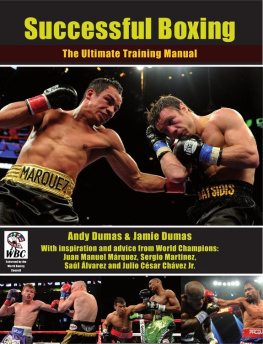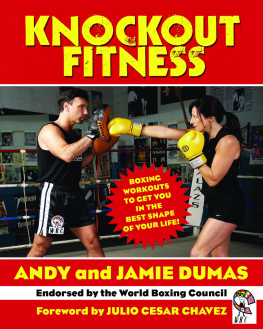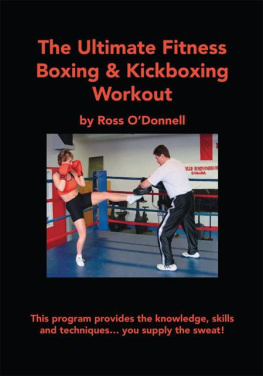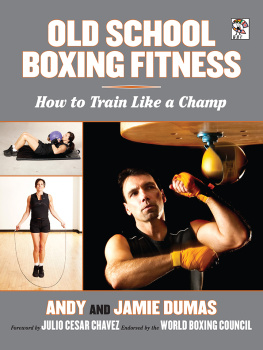
CONTENTS
PREFACE
Id like to say that boxing has always been part of my life, but it wouldnt be true. I came to the sport relatively late, in my thirties. Bored of anodyne workouts, and overweight post-childbirth, I walked off the street on a whim into Clinton McKenzies boxing fitness gym and into a whole new world.
The get fit, not hit mantra may be a clich today, but at that time the idea of introducing traditional boxing techniques to the general public, without the contact and therefore the inherent risk, was pioneering. I took to the training from day one. Within eight weeks I had lost weight and toned up. People noticed; I felt great.
But boxing training is hard work, and even harder was taking it further, into the realms of competition. I was too old to apply for an amateur or professional licence, and it was almost impossible for women to be taken seriously in the male-dominated boxing arena. So I turned to coaching. I supplemented my personal training diploma with a course specialising in focus pad techniques, and started to pass on the boxing fitness revelation to my clients. Today, as a qualified coach and judge for the Amateur Boxing Association, I see the physical and therapeutic benefits of boxing training every day.
It delighted me on all kinds of levels to witness the groundbreaking triumph of the female boxers at London 2012. Id like to say I know what the road was like for them, but it wouldnt be true although I do have an inkling of what kept them battling on, against heavy odds. Boxing has a particular allure, which has at last become accessible to everyone, clients and trainers alike. Its my hope that this book will help you make the most of the professional and personal opportunities it affords. Most of all, Id like it to encourage you to innovate in your career, adding boxing fitness to your repertoire with an original stamp that is truly your own.
Hilary Lissenden
May 2013

A word from the ABA
BOX is the new Amateur Boxing Association REPS accredited training programme for the fitness market.
Training will be rolled out for suitably qualified teachers in schools, colleges and universities, youth workers and sports coaches as well as group and personal trainers in the fitness industry.
The training is based on quality glove and pad work that would be used to prepare boxers for competition but is easily transferable to be used as a means for a general keep fit workout based on boxing movements.

INTRODUCT ION
BOXING FITNESS AND THE EXERCISE PROFESSIONAL
BOXING TODAY PUTTING IT ALL IN CONTEXT
GIRLS IN GLOVES? THATS MADE MY DAY!
Among the many remarkable events and achievements of the London 2012 Olympic Games, people around the world were charmed and delighted by one petite, Leeds-born lass who fought her way to sporting history in the boxing ring.
Standing only 1.64m and weighing less than 51kg, Britains Nicola Adams became the first ever woman to win an Olympic boxing gold, as she beat the Chinese world number one, Ren Cancan, by a resounding 16 points to 7 in the flyweight division.
The ripples of admiration that spread outwards from Nicolas performance were not just for the victory itself; nor were they for the novelty of watching a woman box. They were mostly for the sheer level of skill, fitness and discipline exhibited by this diminutive figure on the royal blue stage of the East London arena.
Girls in gloves? Even the most die-hard doubters could not deny the accuracy and speed of Adams hands, the balance and virtuosity of her footwork, and the focus, determination and courage that together served to make her dream of 15 years become a reality qualities known collectively in boxing as heart.
And if all that wasnt enough to win people over, Nicolas post-bout interview surely did the trick. Asked how it felt to make sporting history, she replied endearingly in her broad Yorkshire accent: Thats made my day, that has.
BACK IN BUSINESS
The ratification of womens boxing as a full Olympic sport was slow in coming, dragging with it an age-old reluctance, even cynicism, about the place of females in the ring that enticing roped-off arena that has been dominated by men since it was first introduced by the Pugilistic Society in 1838.
Boxing itself has had a chequered reputation over the years, with serious concerns raised, among other things, about the safety of its participants. Part of the problem is a persistent confusion between the amateur and professional arms of the sport (no pun intended).
Born out of the ancient pastime of bare-knuckle prizefighting bare-fisted contests between two individuals, with spectators gambling on the outcome boxing had no established regulations until 1867, when the Queensberry Rules formed the basis of the modern sport. Today, in both amateur and professional boxing, contestants tough it out in a ring, over rounds or timed efforts of boxing, wearing padded gloves to minimise injury both to the boxer and to his/her opponent.
But there are essential distinctions between these two forms of the sport. In addition to differences in the judging and scoring systems, professional boxers wear no protective headgear, while amateurs are obliged to. Experienced professionals also box over many more rounds to win their championships a fact which obviously incurs a greater risk of injury.
So while amateur and professional boxing are now strictly controlled by their respective governing bodies, and both enforce stringent safety standards, it is easy to understand why, for example, parents may yet entertain doubts about their youngsters forays into the local boxing gym for sport and recreation.
Boxing fitness training will improve your clients body composition, heart-lung stamina, strength, speed, coordination, balance and flexibility. It also has less tangible but equally important benefits, such as building discipline, confidence and self-esteem especially relevant to schools and young people.
A HEALTHY SPORT
All this makes what Nicola Adams has done for boxing not just womens boxing even more significant. When she climbed into the ring, the picture of fitness, health and vitality, she became simultaneously a poster-person for boxings physical benefits and a role model for its less tangible ones. Her hard-knocks story (she worked on a building site to finance her training) gave her the drive to succeed against the odds, both inside and outside the ring. The Olympic Games were the forum for bringing that message, and its results, to a huge captive audience.

Nicolas Irish counterpart, and gold medallist in the lightweight division, Katie Taylor who trained in a windowless former boathouse with no shower or toilet fought equally hard behind the scenes, putting on exhibitions for the decision-makers as they determined whether womens boxing should be an Olympic sport. Katies success in London brought a whole nation to a standstill as Ireland held its breath unlike the roaring sea of green-clad supporters who witnessed her victory first-hand.
Next page

